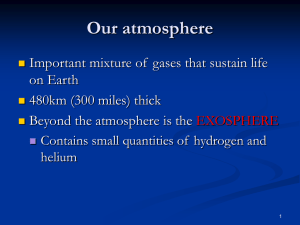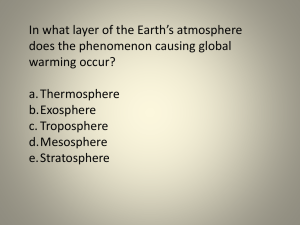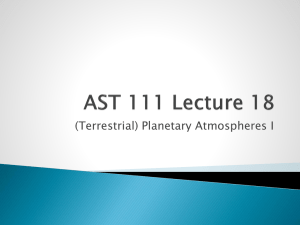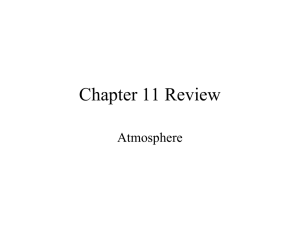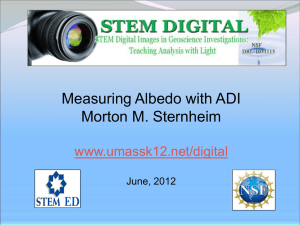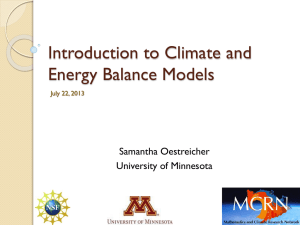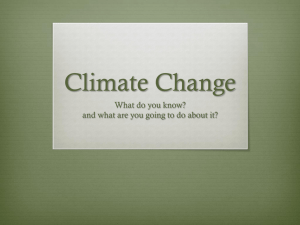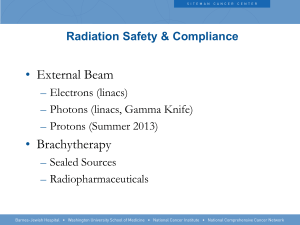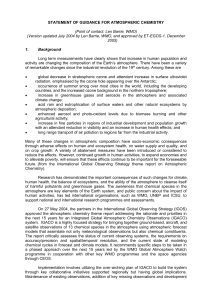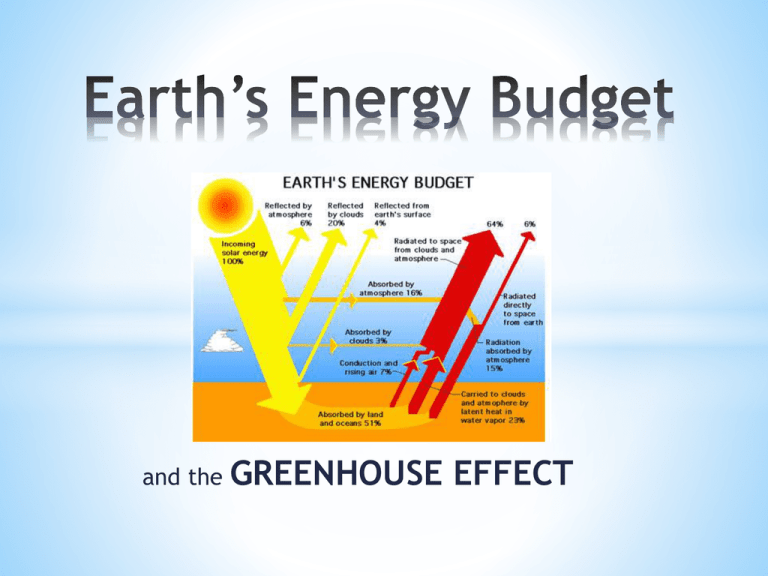
and the
GREENHOUSE EFFECT
What is the difference between Climate and Weather?
Write down what YOU think about this
(are they different? The same?) .
Give a reason for your answer.
Then watch the first 50 seconds of this video.
Write down something that you did not have in your
answer.
*
WEATHER is the state of the atmosphere at a
particular time and place in terms of
temperature, pressure, precipitation,
wind speed (and some other variables)..
CLIMATE is a long term average of temperature,
pressure, precipitation, wind speed,
(etc.) for a particular region on Earth.
*
http://www.ucar.edu/learn/1_1_2_2t.htm
Figure 1: Earth’s stratosphere – the layer in which
our weather systems occur is only 50 km thick –
much less than other layers of the Earth
*Earth’s
Atmosphere
Figure 2: The Layers of the Earth’s atmosphere
Troposphere
Lowest layer where all weather occurs. This layer is
heated from below by the surface of the Earth as it
absorbs sunlight and emits infrared radiation.
Stratosphere
Above the troposphere. Ozone within the
stratosphere absorbs incoming ultraviolet rays from
the sun.
Mesosphere
Located above the stratosphere. The coldest parts
of our atmosphere are located in this layer and can
reach –90°C
Thermosphere
Extremely low density. This layer absorbs some very
high energy radiation from the sun and can heat up
to 1,500°C or higher.
* Climate and weather
A.
B.
C.
D.
E.
are the same thing.
are similar in that they both deal with
atmospheric conditions.
differ in the time frame used to define
them.
both B and D.
are not related to each other at all.
*
*What is the correct order of Earth's atmospheric
layers from bottom to top?
A.
B.
C.
D.
E.
Stratosphere, Mesosphere, Troposphere, Thermosphere,
Exosphere.
Stratosphere, Troposphere, Mesosphere, Thermosphere,
Exosphere.
Stratosphere, Troposphere, Thermosphere, Mesosphere,
Exosphere.
Troposphere, Mesosphere, Stratosphere, Thermosphere,
Exosphere.
Troposphere, Stratosphere, Mesosphere, Thermosphere,
Exosphere.
*
* In which layers does the temperature
decrease as you move higher?
A. Troposphere, Stratosphere
B. Mesosphere, Stratosphere
C. Stratosphere, Thermosphere
D. Thermosphere, Stratosphere
E. Troposphere, Mesosphere
*
What type(s) of electromagnetic radiation are
absorbed by the Earth's ozone layer?
A. Infrared light.
B. Microwaves.
C. Radio waves.
D. Ultraviolet light.
E. Visible light.
*
*
Idea from Miami Museum of Science & IGLO Toolkit
*
The source of this material is the COMET® Website at http://meted.ucar.edu/ of the University Corporation for Atmospheric
Research (UCAR), sponsored in part through cooperative agreement(s) with the National Oceanic and Atmospheric
Administration (NOAA), U.S. Department of Commerce (DOC). ©1997-2011 University Corporation for Atmospheric
Research. All Rights Reserved.
*This is how the sun’s energy gets to the Earth
*Radiation is the transfer of thermal energy by
electromagnetic waves.
*Solar radiation consists of approximately:
-43% visible light
-49% near-infrared
-7% ultraviolet
-<1% x-rays, gamma waves, and radio waves.
*
What happens
when Solar
Radiation hits
Earth's
atmosphere
Image source: http://www.ucar.edu/learn/1_3_2_12t.htm
The source of this material is the COMET® Website at http://meted.ucar.edu/ of the University Corporation for
Atmospheric Research (UCAR), sponsored in part through cooperative agreement(s) with the National Oceanic and
Atmospheric Administration (NOAA), U.S. Department of Commerce (DOC). ©1997-2011 University Corporation for
Atmospheric Research. All Rights Reserved.
Energy from the sun reaches the Earth by
A. Conduction
B. Convection
C. Radiation
D. both Convection and Radiation
E. A, B and C.
*
The sun’s radiation that hits the Earth’s
atmosphere is
A. In the form of short wave radiation.
B. reflected off the clouds back out to space.
C. absorbed by the Earth’s surface.
D. Re-emitted by the Earth as long-wave
radiation.
E.
All of the above.
*
GREENHOUSE GASES (GHG)
are (mostly) naturally occurring gases that allow visible and UV
radiation from the sun to pass through them, but absorb some of
the IR radiation emitted by the Earth’s surface. The GHGs then
re-emit this energy in all directions; some goes back to the
Earth’s surface. Because these gases are able to trap thermal
energy as does the glass of a greenhouse, they are called
greenhouse gases. Since the Industrial Revolution, the
atmospheric concentration all major greenhouse gases have
increased – most noticeably – carbon dioxide.
*
Greenhouse Gas
Water vapour
(H20)
Carbon Dioxide
(CO2)
Methane
(CH4)
Nitrous Oxide (N20)
Chlorofluorocarbons
(CFC)
GWP*
Notes
--
Not assigned a value – concentrations not
significantly influenced by human activity
1
Prior to the Industrial Revolution,
atmospheric CO2 concentration was 280
ppm. Currently it is >394 ppm.
23
Concentrations have more than doubled
since the Industrial Revolution.
298
Source of increases are agricultural
fertilization & animal feed production as
well as from industry.
~3000
Totally human-made. Since the Montreal
Protocol was enacted on 1 Jan 1989,
concentrations of CFC’s have declined.
*Global Warming Potential (GWP)
IPCC Fourth Assessment Report (2007)
GHG & Greenhouse Effect
* VENUS is too HOT (all water would evaporate)
* MARS is too COLD (with an atmospheric pressure too
LOW to allow atmosphere to contain much water vapour)
– but land rover Curiosity is going to find out more!
* EARTH is just RIGHT
having enough water vapour and other GHG to raise
Earth’s temperature enough to allow for life. Water
vapour makes up about 65% of all of the GHG.
Without this, the Earth’s average temperature
would be -18oC.
Dr. Ruddiman summarizes the Natural Greenhouse Effect
*
* Which greenhouse gas is represented by the X
in the diagram below?
A. Water
B. Carbon Dioxide
C. Methane
D. Nitrous Oxide
E. CFC’s
Y
25%
X
65%
*
Z 10%
* Which gas contributes most to the current
increase in the Greenhouse Effect?
A. Water
B. Carbon Dioxide
C. Chlorofluorcarbons (CFC’s)
D. Nitrous oxide
E. methane
*
* What would the average temperature of the
Earth be without the Greenhouse Effect?
A. -40 oC
B. -35 oC
C. -18 oC
D. 0 oC
E. 10oC
*
* Measurements of CO2 in bubbles trapped in ice cores
as well as ratios of isotopes of oxygen and of
hydrogen give us information the ancient atmosphere
and global temperatures.
* This is similar to the indirect measurements that have
let us understand atoms.
* CO2 concentrations have been increasing dramatically
since the Industrial Revolution – largely due to the
burning of fossil fuels. Other spikes occurred in the
1950’s (think number of cars!)
*Enhanced
Greenhouse Effect
ENVIRONMENT
*
Published: December 21, 2010
* Albedo:
“reflectiveness” of a surface
surfaces with a high albedo reflect more incoming solar
radiation
snow, glaciers, and ice have high albedos
surfaces with a high albedo absorb less thermal
energy
Check out the following interactive to see the importance of albedo
on climate.
Earth's Albedo and Solar Radiation
* An Albedo Demonstration has been set up, and
has been running since the beginning of the
period.
* Record your observations on the handout your
teacher has given you.
*
* Which of the following greenhouse gases has
contributed the most to Climate Change since
the Industrial Revolution in the 1800’s?
A. Water vapour
B. Methane
C. CFC’s
D. Carbon dioxide
E. Nitrous oxide
*
Which of the following has the lowest albedo?
A. Clouds
B. Glaciers
C. Forests
D. Oceans
E. Cities
*
* Which of the following statements about albedo and its effect
on global climate is true
A.
As the snow and polar icecaps grow, a decrease in albedo will
result and more solar energy will be reflected from the ice.
B.
As the snow and the polar icecaps melt, a decrease in albedo
will result from the oceans reflecting more solar energy.
C.
As snow and polar icecaps melt, a decrease in albedo will
result in the oceans absorbing more solar energy.
D.
As the snow and polar icecaps grow, an increase in albedo
will result in the ice absorbing more radiation.
E.
As the snow and polar icecaps melt, there will be no effect
on albedo.
*

